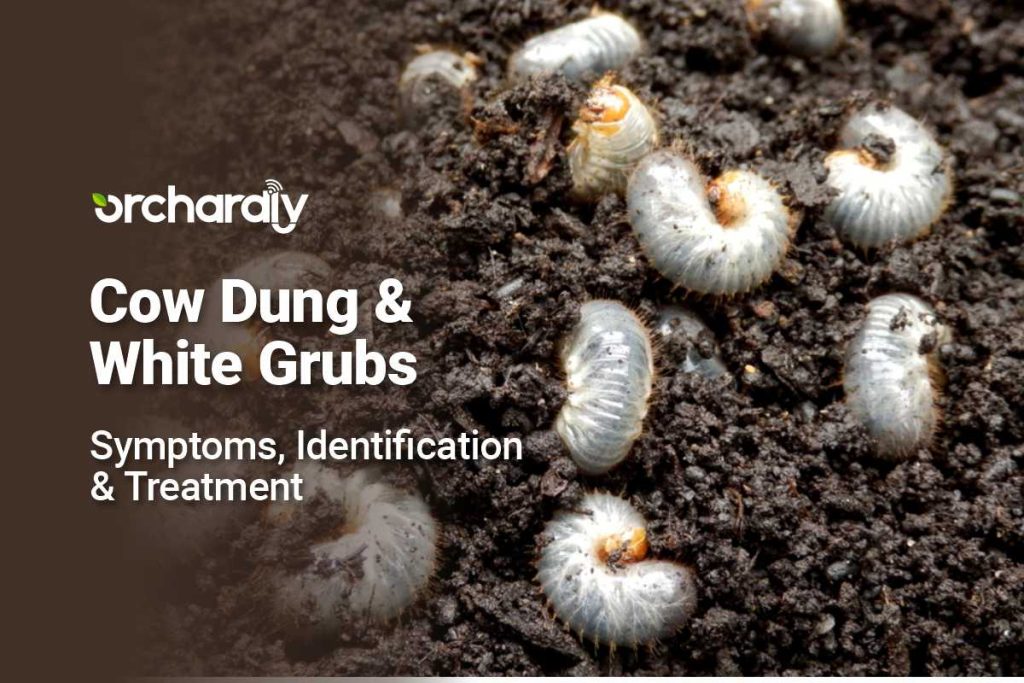There has been an age-old practice of adding manures to the soil to improve soil fertility and crop productivity. Manures provide necessary macronutrients and several micronutrients while increasing organic matter. Manures can range from plant to animal wastes. The most commonly used manure in J&K is cow manure i.e., cow dung. It has relatively less nitrogen than some other manure, hence can be added directly to the soil without damaging plants. It also adds abundant amounts of organic matter and beneficial microbes. However, raw cow dung or fresh cow manure when added to the soil directly without decomposing fully may contain harmful micro-organisms, weed seed, too much salt for dry soil & simultaneously may form a breeding habitation for White grubs.
White grubs are the immature forms of scarab beetles also known as root grubs or June beetles or chafer beetles which are soil-inhabiting polyphagous pests. They mostly feed on organic matter in soil as well as the root system of various economic crops. The crops that are mostly affected include Apples, Cherries, Peaches, Pears and Plums and also wreak havoc in vegetable gardens. These pests in recent years have posed serious and alarming situation at regional as well as national levels and is designated as a ‘National Pest’.
Symptoms
The grubs damage the rootlets, causing wilting of the plants and yellowing of the canopy. In severe case, the plants may even die and can be easily pulled out from the soil. Initially, the crops do not exhibit any symptom but in the long run, their lifespan is reduced and consequently the yields are also reduced. In annual plants, sudden wilting of plants is the most primitive symptom, later followed by premature defoliation. Affected plants are yellowish in color and wilted and mostly die in patches.
In a Nutshell:
- Wilting & yellowing of the canopy
- Death of plants, could be easily pulled out from the soil
- Reduction in yields
Identification
The symptoms are mainly caused by a group of white grubs of the genus Holotrichia spp. Both adults and larvae can damage the plants by feeding on their roots. The adults are dark brown about 20 mm long and 8 mm wide and feed on the foliage of plants. Within 3 to 4 days, after the onset of rains, they emerge from the soil during night time, feed on the surrounding plants and reenter soil to hide and lay eggs. The larvae are whitish yellow in color, translucent, almost 5 mm long and ‘C’ shaped. They feed on organic matter like cow dung which when semi decomposed consists of cellulose and is a favorable breeding place for grubs. Since the roots are also rich in cellulose, the grubs feed on the roots of the plants severing plants at or above the crown.
Pest management
Chemical Control
Adult control
- Spray insecticides during the evening hours on trees and shrubs.
- Imidacloprid 17.8SL (Merit) @ 1.5 ml/lt or
- Monocrotophos 36SL @ 1.6 ml/lt
Grub control
- Incorporate carbofuran 3CG @ 33.0 kg/ha or phorate 10CG @ 25.0 kg/ha in soil before sowing.
- Seed furrow application of insecticides such as, thiamethoxam 25 WS (Meridian) @ 1.9 lt/ha or fipronil 5FS @ 2.0 lt/ha.
- Seed treatment with chlorpyriphos 20EC @ 6.5-12.0 ml/kg or imidacloprid 17.8SL @ 2.0
- Drench the root zone of crop with chlorpyriphos 20 EC @ 4.0 lt/ha or quinalphos 25EC (Ekaux) @ 3.2 lt/ha three weeks after the adult emergence.
Cultural Control
- Place light traps between 7PM to 10PM for the collection and destruction of beetles.
- Trim off trees and shrubs in and around the fields.
- Place pheromone traps in the field (synthetic pheromone- Anisole)
- Collect and destroy the adults fallen near the base of trees.
- Deep summer ploughing to expose the pupae to scorching sun radiation and predation by birds.
- Use well decomposed organic manures such as cow dung which should be dried properly before using it in the fields.
- Take up early sowing if irrigation facility is available.
- Crop rotation with leguminous plants
Biological Control
- White grubs are naturally infested by various entomopathogenic fungi and can be brought into control by a fungus Matarrhizium anisopliae.
- Many entomopathogenic nematodes genera like Steinernema carpocapsae (Weiser), Steinernema feltiae (Filipjev), Heterorhabditis indica (Poinar) and Heterorhabditis bacteriophora (Poinar) can be effective biocontrol agents for controlling White grubs.
- Few predatory birds like Indian myna and Jungle crow can be conserved in the ecosystem as they prey upon both adults and grubs.


